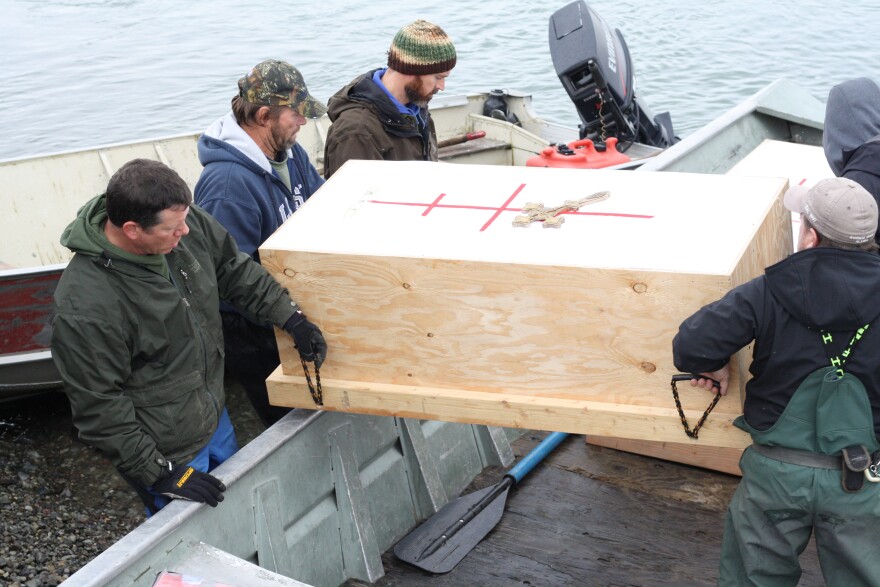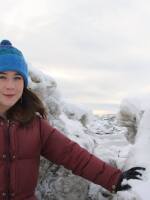In 1931, a Smithsonian anthropologist excavated the bones of 24 men, women and children from a village site near Igiugig. After eight decades in the museum's collection, those remains were reburied near their original places of rest.
About half of Igiugig’s 69 citizens crowded into Saint Nicholas Orthodox church last week. The nave was hazy with incense as the priest conducted the funeral service in a mix of English and Yup’ik. In the center of the room sat three handmade, wooden coffins. Inside were the bones of 24 men, women and children from the now abandoned settlement of Kaskanak.
Their remains were unearthed 87 years ago by Aleš Hrdlička, who was the head of the Anthropology department in what is now the Smithsonian’s National Museum of Natural History. During his 1931 trip to Bristol Bay, he likely excavated remains near Aleknagik, Ekwok, Koliganek and other communities as well.
The question of how people originally came to North America and from where drove him to dig up the bones of Native Americans all around the United States. Historians estimate that he took thousands to Washington D.C. for further research.
After more than eight decades in the museum’s collection, Igiugig’s ancestors finally returned home.

“Our healing now begins,” Rev. David Askoak told the gathered congregation. “We know the sacredness of our graves and our loved ones and those that were there. This is the peace that comes to us. You have to show love to all your loved ones.”
There to help carry the coffins out of the church was Kirk Johnson, the director of the Smithsonian’s National Museum of Natural History.
The Smithsonian is ostensibly an institution that collects objects. Nonetheless, returning pieces of history has become part of its duty in recent decades.
“There was a movement started in the 70s as Native American cultures began to realize that much of their material culture had been appropriated and moved into museums,” said Johnson.
There are several laws that now govern the repatriation of Native American remains and funerary objects. The National Museum of the American Indian Act and Native American Graves Protection and Repatriation Act, passed in 1989 and 1990, require museums to make these materials available to federally recognized tribes.

“Some of their grandparents or their more recent relatives are actually in museums as collection items, which just doesn’t make much sense from a human point of view,” Johnson said. “There is something that is very unfair that was done here, and we want the tribes, groups or corporations to be able to petition to have their bodies or their funerary objects returned to them.”
But that process can be complicated. To start with, when the NMAIA was passed, museums throughout the United States had the remains of about 200,000 Native American individuals. The NMNH had 19,000 of those. The museum catalogued its collection and reached out to tribes with that information, but they cannot simply start sending out bones.
Every repatriation starts with a request made by a tribe. Then the museum works to verify that the remains or objects requested are culturally affiliated with that tribe.

“It’s not easily done. We may have a location, and it may be a name that was written down in the 1880s or the 1920s,” said Bill Billeck, director of the Smithsonian’s Repatriation Office. He was also present at the reburial. “What is that place called today, and what community should we be contacting with? Our strategy has been to send everybody as much information as possible, but that leaves a difficult responsibility on someone in the community to try to figure out, does this actually affect them?”
In the case of this repatriation to the village of Igiugig, the tricky part was establishing the site from where the remains were taken. Hrdlička wrote that he excavated the bones at Kaskanak, but the location of that spot was unclear.
“We went through all the evidence. This is assembling everything from looking at the human remains, looking at the original documents, looking at the diaries of the person who collected the remains and learning from the people in the community the history of the community,” said Billeck.
The Smithsonian’s research leaned heavily on the work of Igiugig local, AlexAnna Salmon. She researched the history of Igiugig and the community’s old village sites extensively for her Master’s thesis. That work became invaluable in establishing that the Igyararmiut, the people of Igiugig, are related to the people of Kaskanak.
She spearheaded the project out of respect for her ancestors. What she didn’t anticipate was the profound impact the repatriation would have on her community.
“This was a collaborative effort between the Smithsonian and our village, but it was really us telling them that these are ours. This is who we are. It’s not anthropology coming from the other direction, telling you who you are and where you came from,” said Salmon. “This has been a part of just reclaiming everything—our native language, our cultural knowledge.”

Alice Zackar is an 85-year-old Igiugig elder. She only speaks her native language. Annie Wilson asked her in Yup’ik what she thought about the repatriation.
“I guess with everything going on she’s kind of a little bit emotional at the moment,” Wilson translated. “But at the moment she feels really honored to have all that taken back down to there.”
Wilson, herself an elder, explained that Hrdlička’s excavation was fundamentally objectionable in Yupik culture.
“We were always taught you don’t dig up old bones of anything or anybody. That’s their resting place until the good Lord comes someday,” said Wilson.
When the bones left the church after the funeral service, they had one more stretch of their journey. The coffins were loaded into a skiff, and the rest of the village piled into a few other boats. The foliage along the banks of the river was bright with fall colors on the 15 minute boat ride from Igiugig to Qinuyang.
It was decided that the ancestors would be reburied there instead of Kaskanak because Kaskanak is now on private property. Qinuyang is a more recently abandoned village site and one that belongs to the village corporation.

At the old site a hole was already dug on the hillside overlooking the Kvichack river. The priest prayed as the coffins were lowered. Then he sprinkled dirt into the graves with a long-handled shovel. He passed the shovel to Johnson. Alongside the director of the NMNH, the children of Igiugig tossed in dirt by the handful. The rest of the village pitched in, and soon only three white crosses and a fresh pile of soil marked the grave.
The bones finally laid to rest, the village performed a yuraq, a traditional Yupik dance. Facing east with dance fans held high, voices raised and drums beating loudly, they blessed their ancestors and reclaimed two dozen members of their community.
Contact the author at avery@kdlg.org or 907-842-5281.



